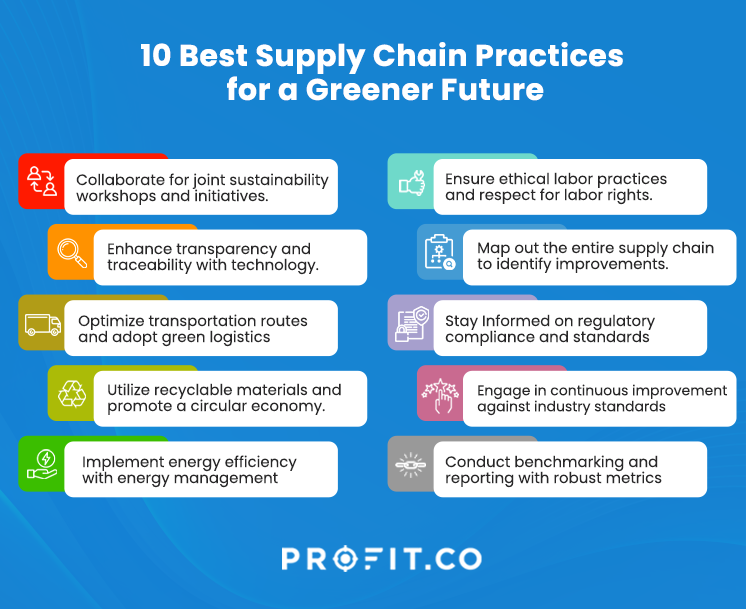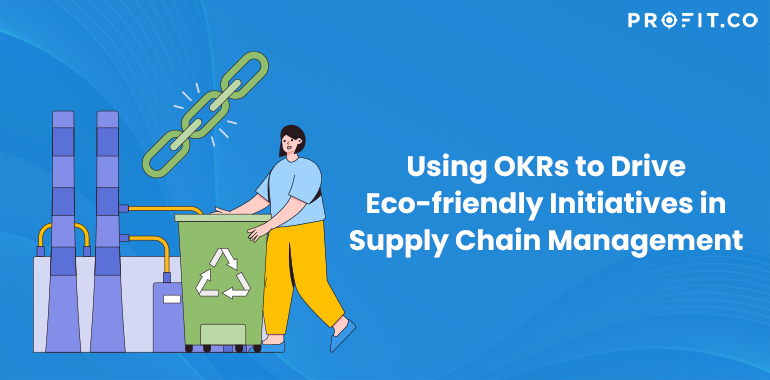Sustainable supply chains are at the forefront of corporate conversations today. Companies are actively shifting towards eco-friendly practices and minimizing waste in a world increasingly aware of environmental impacts. This trend is evident in the growing emphasis on circular supply chains, where businesses adopt recycling, repair, and refurbishment strategies for environmental benefits and to enhance brand value. Furthermore, legislative developments like the EU’s Corporate Sustainability Reporting Directive and the Corporate Sustainability Due Diligence Directive reinforce this shift, mandating companies to be accountable for their environmental and social impacts. These legislative changes and a societal push towards sustainability make it clear that sustainable supply chains are not just a trend but a vital aspect of modern business operations.
What is a Sustainable Supply Chain?
Why is this such a hot topic? Well, the big reason is the urgent need to tackle climate change. Put succinctly, a sustainable business has minimized the negative environmental and social impact caused by its operations. The standards that a business follows are usually determined by ESG metrics: Environmental, Social, and Governance ratings.
Here, we will discuss the part of business operations usually responsible for most pollution: the supply chain.
A supply chain refers to every process in turning raw materials into goods eventually sold to the customer. That involves manufacturing, sourcing, chemical processes, transportation, and more. All the processes that would release pollutants are typically part of the supply chain. That is why it has become a significant priority for those who work in supply chain management to figure out how to reduce it.
The typical supply chain creates far greater social and environmental costs than expected, accounting for over 80 percent of a company’s greenhouse gas emissions and more than 90 percent of their effect on air, land, water, biodiversity, and geological resources. One of the most popular transportation methods is shipping, especially for international trade. It is responsible for 90% of international trade to put that into perspective, and it is also responsible for much of the pollution and damage done to the ocean. Thus, we can see why finding ways to mitigate this has become a top priority for many companies.
Why do we Need Sustainable Supply Chains?
A good guide on how businesses focus their efforts is the triple bottom line, which refers to “people, planet, and profit.” In pursuing financial growth, you would also keep tabs on the social and environmental aspects. Making these part of your mission statement communicates responsibility and awareness to your customers, who have expressed greater appreciation for socially responsible companies.
Sustainable supply chain benefits
- Reduced costs
As companies are being held increasingly responsible for their waste, removing the source of the pollution would be more cost-effective than paying for the clean-up. When companies use less, they waste less. - Reliable supply chain
Identifying wastage and vulnerabilities along the supply chain allows managers to plan ahead and decide how to diversify optimally. - Public relations
In an age where all actions are constantly under scrutiny, sincere and transparent efforts to contribute socially will better win the loyalty of your customer base. People Like Companies that Care.
A good example of this is Patagonia. An outdoor clothing company has gained massive popularity by focusing on sustainable sourcing. It heavily relies on using recycled polyester and organic cotton in its products while implementing fair labor laws along its supply chain. The value of these practices is further emphasized by making their work transparent with regular public updates. So, if Patagonia can implement sustainable supply chains, where does this difficulty arise for other companies?
Sustainable Supply Chain Best Practices
The best way to understand sustainability is to simply look at the industry standards. What are the tried and tested methods companies have used to maintain a sustainable supply chain?

Supplier Collaboration
Share and encourage your sustainable values with your suppliers to incorporate sustainability throughout the supply chain by regularly engaging in joint sustainability workshops or initiatives.
Transparency and traceability
Leverage advanced technologies like Blockchain, Internet of Things, Artificial Intelligence, Machine Learning, Big Data, RFID, and GPS Tracking to enhance the traceability of materials through the supply chain, thereby increasing visibility, accountability, and identifying sustainability issues effectively.
Efficient transportation
Optimize logistics and distribution by implementing route optimization software, investing in eco-friendly vehicles, and exploring alternative transportation methods like rail or sea, often more sustainable than road transport. Additionally, consider adopting electric or hybrid vehicles and collaborating with green logistics providers to reduce carbon footprint and fuel consumption further.
Reduce packaging
Increase the use of recyclable materials in packaging while reducing waste and your overall impact on the environment. This can be further improved by encouraging customers to return packaging to help create a circular economy.
Energy efficiency
Improve your manufacturing and operational processes by integrating solar panels or wind turbines, significantly reducing carbon emissions and energy costs. Moreover, consider implementing energy-efficient equipment and smart technologies that optimize energy usage, like LED lighting, energy management systems, and automated controls. These measures contribute to a greener supply chain and improve long-term sustainability by reducing reliance on non-renewable energy sources.
Public relations
Commit to maintaining fair labor practices and ensuring safe working conditions for all employees throughout your supply chain. This involves going beyond basic compliance and actively encouraging a workplace culture that gives importance to employee well-being, offers fair wages, and respects labor rights. Additionally, consider implementing regular audits and training programs to promote awareness and adherence to ethical standards.
Map out the entire supply chain
Be aware of every step, from when the goods are sourced to when they are delivered to the customer, to identify areas for improvement. This comprehensive mapping is crucial for pinpointing areas where sustainability can be enhanced, such as reducing waste, optimizing resource usage, or identifying alternative, more sustainable suppliers.
Regulatory compliance
Stay updated on sustainability regulations and standards, ensuring full compliance across the supply chain. A proactive approach like this reduces the risk of non-compliance and associated penalties and positions your company as a responsible and forward-thinking leader in sustainability.
Continuous improvement
Regularly inform yourself of the latest regulations and advancements in sustainability to stay ahead of the game and adapt to an ever-changing business landscape. Regular updates against industry standards and competitors can provide valuable insights into your progress, highlighting areas for further optimization and showcasing your achievements in sustainable practices.
Benchmarking and reporting
The best way to measure your progress is to ensure you have reliable metrics and reports from your supply chain. These reports should not just focus on compliance and avoiding fines but also on measuring improvements in areas like energy efficiency, waste reduction, and ethical practices.
You’ll find most companies try to follow these practices to varying degrees. Nevertheless, it is not as easy as one might think. It takes time and effort to do these, especially when unfamiliar.
Want to hear more about OKRs?
Why is it Hard?
A supply chain manager’s job is to find the best way to add value to the company. Managers implement changes along the supply chain so that the benefit is felt at the end with greater profits from selling the goods while making sure that the customer receives quality goods at a competitive price. Supply chain management has followed this framework for decades and it’s worked. The problem that arises now is that customers attribute value to the eco-friendliness of your product. Calling it a problem may even be a misnomer as this is simply the result of people becoming more aware of the companies they rely on. This means there needs to be a re-prioritization of objectives for supply chain managers. Not only do they need to consider their previous objectives, but they also need to balance them with improving the sustainability of their supply chain.
This can seem daunting for some, but effective change can be made with a well-chosen methodology. To that end, the OKR methodology would be effective. Developed in the 90s, it has been an accredited method of success for many of today’s tech giants, including Intel, Google, and Amazon. In addition to measuring performance, the OKR methodology shines as a method of creating systemic change in your business. You use this to improve your operations and encourage employees to become more committed and creative in their methods.
Creating a Sustainable Supply Chain with OKRs
OKRs (Objectives and Key Results) are a powerful tool for organizations striving to break free from the status quo and explore ambitious goals. By setting aspirational objectives, OKRs encourage employees to push beyond their usual limits. It’s not just about achieving these goals; it’s about the journey towards them and the invaluable lessons learned along the way.
Want to hear more about OKRs? Click here.
Sustainability managers often have clear targets like no wastage, minimal emissions, strict adherence to safety regulations, maintaining healthy work environments, zero exploitation, and ensuring total transparency. These goals can be a focal point in a sustainable supply chain strategy. When crafting OKRs for sustainability, aligning them with your business’s unique needs and context is essential.
Here’s how you can effectively develop OKRs to foster a sustainable supply chain
1. Evaluate your Supply Chain: Depending on the size of your business, your supply chain could be of varying complexity. Regardless, you must be fully aware of the different steps so that you might recognize the weak points.
2. Choose an Objective: Choose the most important goal to be accomplished and make that your Objective. This is better done with input from your team for a holistic perspective. Objective: Significantly Reduce CO2 Emissions
3. How to achieve this objective: Given how complex a supply chain can be, it also means there can be various solutions. With input from different team leaders, you should set 3-5 key results to work towards. Ensure there is alignment with the overarching organization goals.
- KR1: Cut total CO2 emissions by 20% within a year
- KR2: Reduce employee commute emissions by 15% in six months
- KR3: Increase renewable energy use by 30% in nine months
These objectives and key results are visible and transparent across the organization so employees can see the progress of these key results.
4. Communicate: A supply chain is widespread and composed of different individuals. All levels need to be told what the OKRs of the organization are and then form their OKRs to see how they might individually contribute.
5. Monitoring and Adjustment: OKRs are dynamic, focusing on outcomes and the methods used to achieve them. This approach necessitates frequent check-ins and comprehensive reviews. While weekly check-ins are common, allowing for timely adjustments and feedback, quarterly reviews provide a broader perspective on progress and strategic alignment. This regular assessment rhythm ensures goals are met effectively, with data-driven insights guiding decisions and potential course corrections.
6.Continuous evolution in sustainability: Sustainability in supply chains is an ongoing journey marked by iterative learning and adaptation. Success in one area often reveals new opportunities for improvement elsewhere. Embrace this evolving process by consistently applying the insights from successful initiatives to enhance other aspects of your supply chain. This approach ensures continuous improvement, keeping your sustainability efforts dynamic and effective.
As you complete one objective, you may find several more to complete. Sustainability is a long process that requires constant reflection and adjustment, but the results only benefit the business and the economy in which you operate. Nevertheless, any problem can be broken down if you approach it correctly, which is why the OKR methodology fits so well.
